Arts & Entertainment Community
Gig Harbor Now and Then | The lost machinist
The Gig Harbor Commercial Fishermen’s Civic Club has recently honored Howard Cox with an engraved notation at Gig Harbor’s Ancich Waterfront Park. On the mechanical side of the business, Cox was a nearly indispensable partner of many boat owners. His technical ingenuity and metal fabrication skills became legendary early in his career at Gig Harbor Machine Works on Harborview Drive, and held steady throughout his life.

Howard Cox has been honored with an engraved paving stone at Gig Harbor’s Ancich Waterfront Park. Photo by Greg Spadoni.
Though singled out on the plaque, Howard Cox was not alone in his position in Gig Harbor as a valuable mechanical innovator and builder of commercial fishing and other marine equipment. In fact, he was a successor in the role.
The prelude to Howard Cox
As sometimes happens, such a long and successful tenure as Howard Cox had in his business has overshadowed the man who came before him. That’s especially unfortunate for the British-accented Albert Fleuss, who founded Gig Harbor Machine Works, the very same shop that Cox operated for decades, may well have been Howard Cox’s equal.

This photo of Albert Fleuss appeared in the June 14, 1931, Tacoma Daily News.
Albert Fleuss was one of Gig Harbor’s leading businessmen and community leaders from 1925 to 1939. As a machinist and fabricator, he set the standard for excellence that Howard Cox continued. There had been several others who tried to maintain what Fleuss had established, but none succeeded until Howard Cox came on board, five years after Albert’s death.

This June 6, 1930, ad in The Peninsula Gateway for Gig Harbor Machine Works was found in the Harbor History Museum.
A certain pedigree
Albert Fleuss was born in New Town, Isle of Wight, England, with mechanical ingenuity in his blood. His father, Henry Fleuss, is credited with having invented many things, most notably one of the earliest forms of underwater breathing apparatus. The elder Fleuss also invented, patented, and manufactured tubeless tires (“tyres” in British-speak) for bicycles in the 1890s, 50 years before B.F. Goodrich made them practical for automobiles.

Fleuss tubeless tyres (tires) were a selling point for this bicycle in Manchester, England, in 1901.
Albert also had adventure in his soul, for in 1899, at 16 years old, he shipped out of England on a tramp steamer that travelled to such diverse locations on his first voyage as the Mediterranean Sea, the Black Sea, Russia, and Baltimore before returning to London.
He gave up sea life for a career as a general mechanical engineer, going into business with a partner, J.P. Sparkes. The partnership was dissolved near the end of 1907, and it wouldn’t be too much longer before his British residency dissolved as well.
A long route to Gig Harbor
Albert married Ellen Mary Allen in England in December 1908, but his wife was not with him when he went to Canada in July 1909. He arrived at Vancouver, British Columbia, not from England, but from Australia. His 24-day voyage from Sydney, as a passenger in steerage on the steamship R.M.S. Marama, included stops in Brisbane, Fiji and Hawaii.
He briefly settled in St. Catharine, Canada, before coming to the U.S. in 1910 through Niagara Falls, New York, destination Buffalo. His mother, Rosabelle Fleuss, estranged or divorced from his father, also left England and ended up in the U.S., but moved back to Canada for some years before relocating to Washington for good.
Immigration documents can be a wealth of information, and they can also be conflicting. At the age of 27, when he arrived in Niagara Falls, Albert was listed as five feet, five and one-half inches tall. Yet three years later his Declaration of Intention to become a U.S. citizen gave his height as five feet, four inches. Could he have been stooped by an injury, or simply mismeasured? Whichever was correct, according to his 1918 military draft registration, he was considered to be of medium height.
On the same declaration, he listed himself as single, rather than widowed or divorced, effectively erasing his first marriage.
At some point Albert moved to Seattle. Only a few fragments of his life there could be found. His primary occupation was as a machinist for the Motor Parts Co.
In 1913 he owned a six-horsepower Yale motorcycle. The same year, he married 23-year-old Fannie Jorgenson. She died in 1914 due to complications of a thyroid operation. He remained single until marrying for the last time in 1922, to Nancy Cooke who, like himself, was a native of England. (For unknown reasons, perhaps just to make things difficult for history researchers, she sometimes went by the first name of Annie in both England and America.)
Albert and Nancy moved from Seattle to Gig Harbor in 1925. What persuaded them to go there isn’t known, but it was the right move for both the couple and the town. They rented a house while Fleuss built his first machine shop that summer. He obviously had some sort of arrangement with Andrew Skansie, for he built it on Skansie property months before purchasing the land.
On Oct. 28, 1925, Albert and Nancy (listed as Annie Fleuss on the deed) paid $300 to Andrew Skansie for the 6,000 square feet of land on which the machine shop stood. The lot was (and still is, although it’s now 50% larger) adjacent to the southeast border of the Millville plat on the west side of the bay.
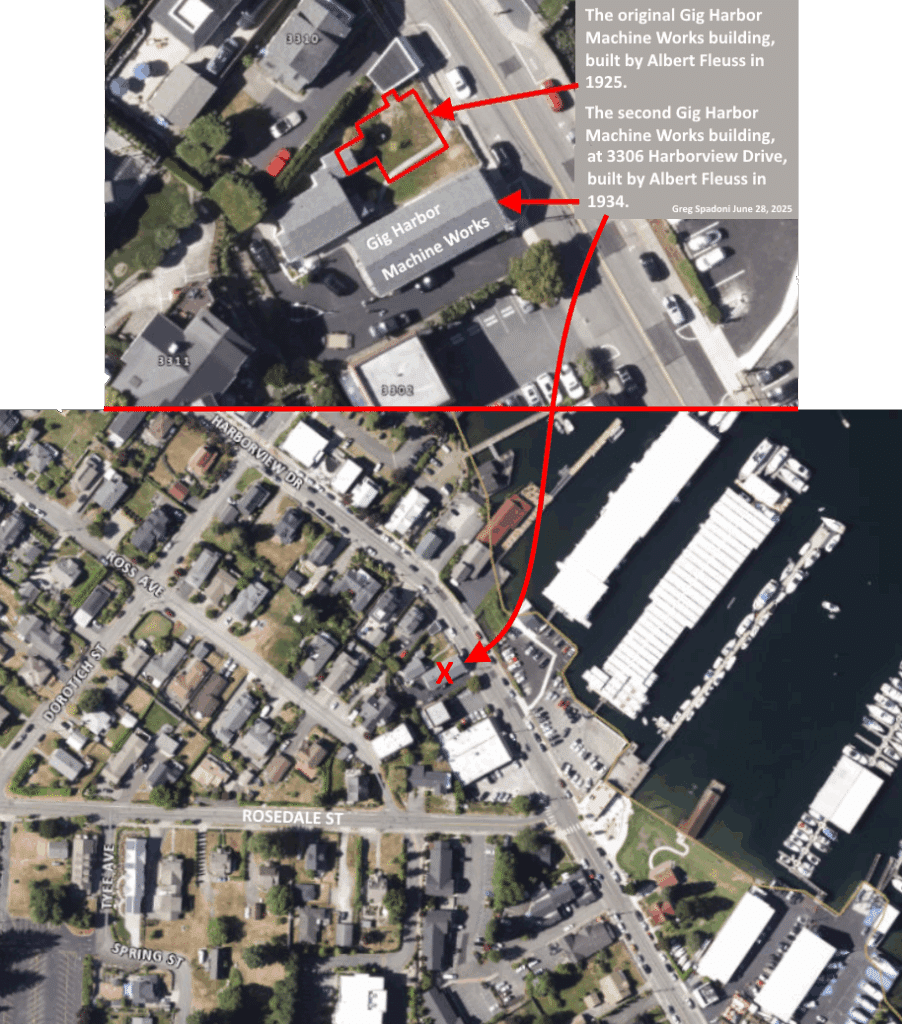
Albert Fleuss built two machine shops on his property on Harborview Drive in Gig Harbor. He put up the first one in 1925, and the second in 1934. Pierce County Assessor-Treasurer aerial base map.
Business was good
Fleuss quickly established himself as a critical go-to guy for Gig Harbor’s commercial fishing fleet, ferry boats, loggers, farmers, and anyone else who needed his skills. The Jan. 14, 1927, Peninsula Gateway said that because of the rapid growth in business, “Mr. Fleuss has found it necessary to add equipment quite frequently.” The story went on to say that “All power rolls installed on fishing boats built in Gig Harbor have been made at the Gig Harbor Machine Works from the pattern making up. Nothing but rough castings and shaftings have been secured outside.
“One of the most important parts of a power roll is a slipping clutch which was designed by Mr. Fleuss. The slipping clutch in question is not only suitable for power roll transmission, but can be used wherever power is to be transmitted; in mill, mine, or factory.
“Besides the work above mentioned the Gig Harbor machine works has done a lot of repair and job work for the … ferry company and for all the local loggers.
An addition was recently added to the main building to make room for an oxygen and acetylene welding plant.”
With the new machine shop doing ever increasing business, Fleuss built a small house on the property in 1929, where he lived for the rest of his life.
Subcontracted for Skansie and Crawford
More evidence of the importance of Albert Fleuss to the Gig Harbor fishing industry comes from 1930. He built and installed the steering gear, power roll, and winch on John Skansie’s new boat, Claremont, the largest fishing boat built at the Skansie shipyard that year. He also built and installed the winch and power machinery on Lee Makovich’s new boat, Advocator, built at the Crawford yard at north Gig Harbor, and captained by John Ross. (A beautiful scale model of Advocator is on display at Gig Harbor City Hall.)
There’s no telling how many more boats he similarly outfitted that year. Those two were the only ones mentioned in Tacoma newspapers.
Big problem solved
A major example of the ingenuity of Albert Fleuss was displayed in 1931, when he designed and built an improved clutch for the four-year-old Skansie-built automobile ferry Defiance. It needed to handle, with finesse, the output of the boat’s 360-horsepower diesel engine. The June 14, 1931, Tacoma Daily News included a photograph of Fleuss with the clutch before it was installed. The caption read, in part, “The new clutch recently installed in the ferry Defiance … solved the problems of handling that big vessel, according to Capt. Domingo Scarponi [sic]. This clutch, which enables the captain to park the vessel where and when he pleases without having it start to climb out on the dock as it did with the old one, was designed and built by A.H. Fleuss, who has a machine shop here and is something of a genius in solving the problems brought to him by shipping men and fish boat operators.”
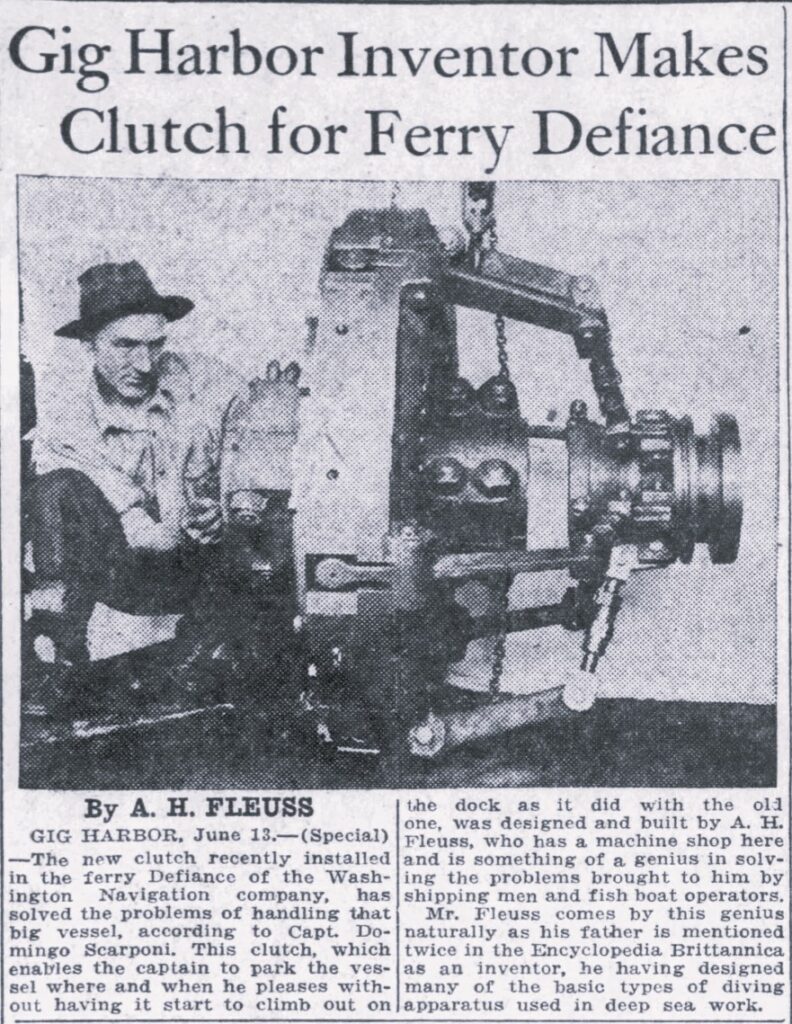
Albert Fleuss solved a serious ferry boat problem in 1931 with an engine clutch of his own design and construction. This clipping is from the June 14, 1931, Tacoma Daily News.
As to be expected, with so much work coming to Albert Fleuss, the machine shop was not a one-man operation. He sometimes needed a lot of help. In 1931, The Peninsula Gateway concluded a short profile of the business with, “At times the Gig Harbor Machine Works carries quite a large pay roll and has proven itself of great benefit to our people in many ways.”
More expansion
The non-stop growth in business Albert Fleuss was generating — in the depths of the Great Depression — necessitated another expansion of shop equipment and space. Instead of adding onto his first building again, in late 1933 he bought the lot next door and started putting up a new one, which stands today as the home of Local Whimsy, a gift shop, at 3306 Harborview Drive. Fleuss hired Philip Brautigan of East Gig Harbor to excavate for the foundation and do the concrete work. Harry Howse, a former proprietor of the West Side Mercantile store, did the carpentry. Fleuss moved into his new shop at the beginning of 1934.
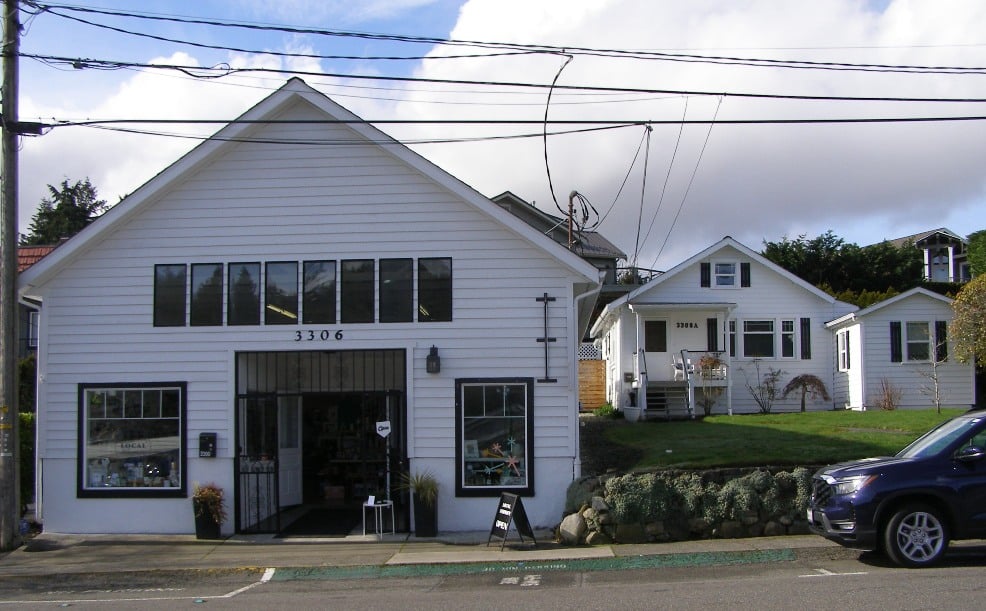
The former Gig Harbor Machine Works building at 3306 Harborview Drive in Gig Harbor, built in 1934 by Albert Fleuss, is now occupied by Local Whimsy. The Fleuss house, on the right, was built in 1929. Photo by Greg Spadoni.
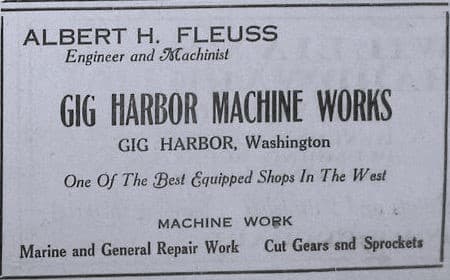
This ad for Gig Harbor Machine Works, in the May 14, 1937, Peninsula Gateway, was found at the Harbor History Museum.
Not just a businessman
Aside from his thriving machine shop business, Albert Fleuss and his wife Nancy were very involved with Gig Harbor civic affairs. He was a member and officer of the Gig Harbor Lions Club, and she was involved in a variety of causes, including the St. John’s Guild, the Red Cross, and the Amateur Garden Club. She also coordinated the Tacoma Goodwill truck’s pickups in Gig Harbor.
Albert Fleuss died in late 1939 at the age of 56. The Peninsula Gateway charitably attributed his death to a nervous breakdown, but the actual cause was “cerebral thrombosis luetic.” (For those who steadfastly refuse to click on links, that’s a stroke due to syphilis. Doesn’t that make you wonder what else you miss by not clicking on links?)
After Albert’s death, his wife hired Alex Moir of Longbranch to operate the machine shop. In early 1940 she leased the shop to Ivan McKenzie, with him specializing in acetylene and arc welding, and Moir staying on as the machinist. The first advertisement for the shop with the new crew in The Peninsula Gateway, on April 5, 1940, specified “arc-welding and acetylene” and “all kinds of machine work.”
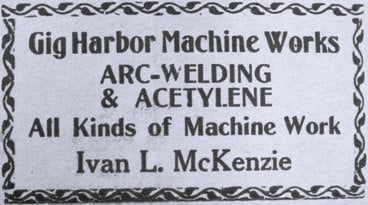
This ad for Gig Harbor Machine Works, in the April 5, 1940, Peninsula Gateway, was found at the Harbor History Museum.
Ivan McKenzie didn’t stay long at the Gig Harbor Machine Shop. His advertisement for welding just one month later in the May 3 Peninsula Gateway didn’t mention the shop. On May 24 the Gateway had this note on Ivan: “I L McKenzie has taken over the Clipper gas station from Harold Smith. He also does ark [sic] welding in connection.”
John Galbraith, who sometimes looked like he was buying up the whole town in the 1940s, was the proprietor of the Gig Harbor Machine Shop in 1942, although Mrs. Fleuss remained the owner of the building. It’s not known who was operating the shop for Galbraith, who was too busy with a variety of other businesses in Gig Harbor and several other towns in Pierce and Kitsap counties to be a daily fixture at any of them.
Howard Cox takes over
Howard Cox first worked at the shop in late 1944 along with another long-time local machinist, John McConaghy. Cox bought the business, the building, and the house at the beginning of 1945 from Mrs. Fleuss. (In 1948, McConaghy opened his own machine shop on Soundview Drive.)
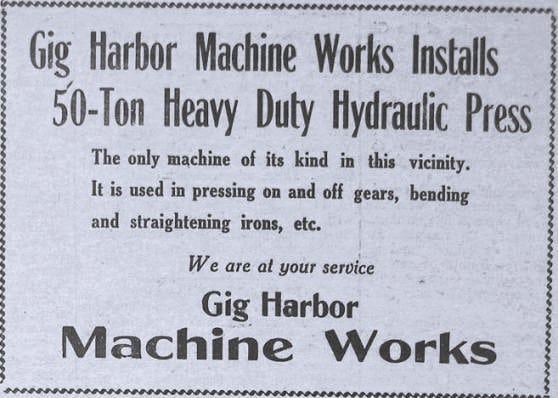
Like Albert Fleuss before him, Howard Cox added new equipment to the machine shop as needed. This ad for his Gig Harbor Machine Works, in the February 17, 1950, Peninsula Gateway, was found at the Harbor History Museum.
The shadow of his successor
There are probably two reasons the exceptional Albert Fleuss is no longer remembered: The much longer career of the equally exceptional Howard Cox and the fact that all of his customers and friends are long dead.
Given his accomplishments and importance to the town, it would be difficult to argue against Fleuss deserving an equal mention on the same tile at Ancich Waterfront Park that honors his successor. Being forgotten is definitely the wrong fate for such an accomplished man.
Without Albert Fleuss, there would never have been a Gig Harbor Machine Works. Had there been no such place, Howard Cox would still have been every bit as skilled and resourceful as a machinist and mechanic, but would he have ended up in Gig Harbor?
Considering that he came to town specifically to work at Gig Harbor Machine Works, the answer is probably no.
Surplus notes
The interesting points not used in today’s story include a bit of mystery surrounding Albert’s relationship with his father. There are no indications of Albert or his mother ever having contact with Henry Fleuss after they came to North America. There is no proof that Rosabelle and Henry were ever divorced, but it seems likely. Albert never visited England after moving to Gig Harbor in 1925, though his third wife, Nancy, did in 1934.
Although it wasn’t mentioned in all newspaper accounts of the estate, when Henry Fleuss died in England 1933, he did not cut Albert out of his will. At least two reports of Henry’s estate settlement noted the disposition of only the bulk of his assets. “Testator left his furniture and personal effects (not otherwise disposed of) and his motor car and cash [5,068 British pounds, or about $21,000, equivalent to about $535,000 in 2025] on current deposit account at Lloyds Bank to his secretary and housekeeper, Annie Grace Redknapp.”
A less edited account of Henry’s will includes, “… and the residue of the property to his son, Albert Henry Fleuss.”
There’s no explanation of what “the residue of the property” consisted of, or if Albert ever took possession. Had he gone back to England to claim it, The Peninsula Gateway would’ve reported his absence from Gig Harbor, but it did not. Perhaps it was liquidated and the proceeds sent to him in Gig Harbor. It would be baseless speculation to assume that his inheritance paid for his new machine shop building later the same year.
In his own will, Albert provided for his mother to receive $40 per month from his estate for the rest of her life, but she predeceased him. His wife, listed as Annie, was his sole heir. His will was witnessed by Louisa Cruver and Louise Uddenberg (her daughter).
Louisa Wilkinson Cruver was the sister of William Wilkinson, of Gig Harbor’s Wilkinson Farm Park. The siblings were both born in England. Could the Wilkinson and Fleuss families have known each other there, or was the common heritage a basis for their friendship in Gig Harbor? Could the Wilkinsons have known Nancy Fleuss’ family in England?
This brief note from the July 26, 1940, Peninsula Gateway is an example of Nancy Fleuss’ continuing engagement with the community after Albert died: “Anyone wishing to do knitting can get yarn and instructions from Mrs. Fleuss.
Nancy/Annie Fleuss lived in Gig Harbor and Tacoma for several years after Albert’s death. She then moved to England for a while before coming back to Pierce County, possibly for a visit, rather than residency. She returned to England permanently in 1949, where she died in late 1963. Someone there was kind enough to inform one of her Gig Harbor friends, Mrs. Marvin J. McCray (the former Jeroma Skansie, daughter of Andrew), of Nancy’s death. Mrs. McCray in turn sent a short letter with the news to the editor of The Peninsula Gateway, who published it in the newspaper.
Considering construction dates
The former machine shop building at 3306 Harborview Drive is a prime example of the limits of the original construction dates on the Pierce County Assessor-Treasurer Information Portal online. Before about 1960, the building dates of houses and other structures in the rural parts of the county seem to be guestimates rather than actual dates. They are very often wrong, and sometimes wildly so.
In this example, Albert Fleuss started construction on the 3306 building in 1933, and occupied it in 1934. The construction date listed on the Pierce County Assessor-Treasurer Information Portal for that structure is 1940.
While the dates on the Pierce County Assessor-Treasurer Information Portal can serve as a general guide for older buildings, they should not be relied upon for specific construction years.
Continuing business
Tonya Strickland has posted another entry in her Behind the Finds series on Gig Harbor Now. Number 6 in the series tells how the Persings and the Wolfords got together. Just to stay current with the new chapter, I slipped back in time to Burton Persing’s era to pose next to him wearing a crotch apron Tonya found in a second-hand store across the street from where we found the Persing/Wolford/Sharman photos.

B B Persing and Greg Spadoni showing off their stylish crotch aprons with justifiable pride. Photo (the right half, anyway) by Tonya Strickland.
Due to the limited (read: non-existent) Gig Harbor Now and Then expense account, I couldn’t quite afford to get all the way back in time, but I got close enough to smell the stale cigar smoke on Burt’s clothes. And if he wasn’t dead, he probably would’ve smelled the fresh garlic chicken on my breath.
Next time
As we occasionally do, next time we will have another hard-hitting Gig Harbor Now and Then editorial opinion. No editorial board anywhere has tackled the subject we will on July 14. Circle the date on your calendar (or whatever you do on your smart phone). It will be destination reading.
— Greg Spadoni, June 30, 2025
Greg Spadoni of Olalla has had more access to local history than most life-long residents. During 25 years in road construction working for the Spadoni Brothers, his first cousins, twice removed, he traveled to every corner of the Gig Harbor and Key Peninsulas, taking note of many abandoned buildings, overgrown farms, and roads that no longer had a destination. Through his current association with the Harbor History Museum in Gig Harbor as the unofficial Chief (and only) Assistant to Linda McCowen, the Museum’s primary photo archive volunteer, he regularly studies the area’s largest collection of visual history. Combined with the print history available at the museum and online, he has uncovered countless stories of long-forgotten local people and events.
